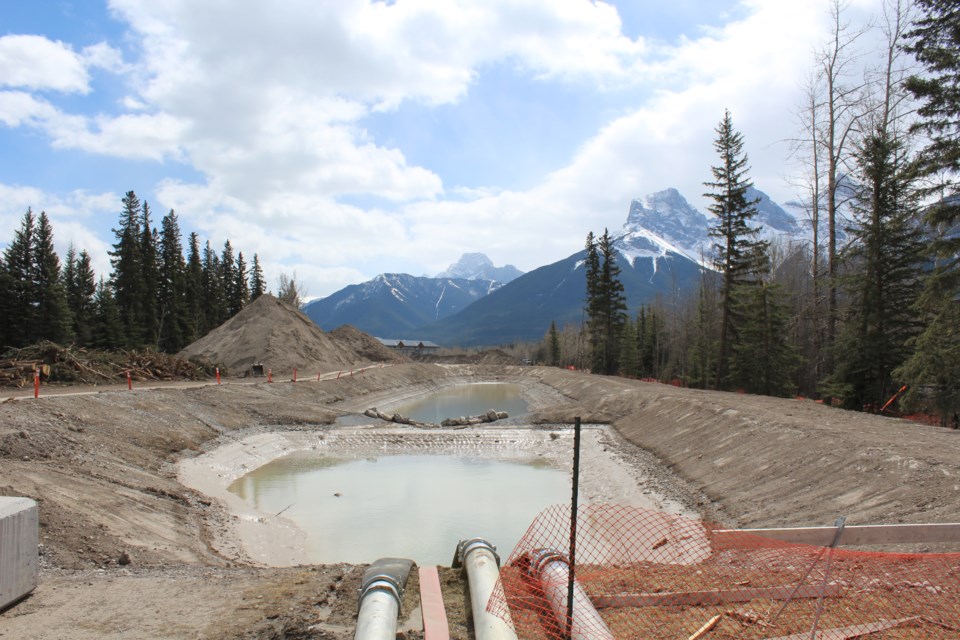CANMORE – As the Town of Canmore moves forward with a major deep utility and road reconstruction project within the busiest intersection in the entire community, high groundwater levels are requiring the use of a nearby de-watering area.
The large trench is being used to funnel groundwater from the excavation needed to replace the water and gravity-fed sewer lines from William Street to a lift station near the A&W and CP Rail line.
Manager of engineering services Andy Esarte said the water and sewer utility lines along Bow Valley Trail date back to the 1960s, do not have the capacity to accommodate future growth in the area and require upgrading – a $5.3 million project.
"This is the second phase to connect across the tracks and build the utility to tie back into the line in Bow Valley Trail for sewer," Esarte said, adding last year the municipality upgraded the connection to the lift station as the first phase.
"That increases the capacity, so it can handle expected future flows and this is all work done based on modelling from the 2016 utility master plan."
Another outcome from upgrading the water lines, he added, was to meet the needed flow rates for fire response capabilities.
"The main part of this project is getting [water and sewer lines] across the tracks and through the intersection at Bow Valley Trail and Railway Avenue up to William Street," Esarte said.
The valley bottom in Canmore is well-known for its high groundwater levels especially in the spring. Esarte said numerous projects over the past 20 years have had to use de-watering trenches to manage those water levels during construction.
With one of the deep utility lines being replaced being a gravity-fed sewer line, he explained the trench work leading to the lift station has to go deeper into the ground.
"As we are crossing the tracks, we are nearly six-metres deep with our excavations and the ground water levels are typically 1.5- to three-metres deep depending on the time of year in that area," Esarte said.
"We are dealing with several metres worth of groundwater pressure coming through during excavation in really permeable gravel."
By pumping the groundwater into a nearby trench, he said there are less delays and the work can proceed at a quicker pace than without it.
"We had the opportunity for this project to work with a landowner and lease a parcel that allowed us to build a large infiltration area and at this point the groundwater has been cooperating," he added.
The groundwork for the deep utilities is expected to be complete by mid-May, when groundwater levels in the valley are at their highest, with that portion of the overall project expected to be complete by mid-June.
The second phase of the 2020 capital project will see the municipality's new street design incorporated into the intersection as it is rebuilt.
That redesign has a budget of $8 million and Esarte said tenders for it closed last week.
"We are pushing forward with that and the challenge we have had this spring is we have had several large projects tendered and we were in the process of contracting them with a new reality and COVID-19," he said.
The "new reality" means incorporating health and safety language into contracts to reflect requirements to prevent the spread of COVID-19 for workers. With the guidance of Alberta Health Services and guidelines created by the Alberta Construction Association, all local municipal contracts for projects now contain language to protect workers from spread of the virus.
Another effect of the pandemic on municipal capital projects has been on the prices for materials, and supply chains that involve supplies that are being obtained outside Canada.
Esarte said for the most part he has seen prices come down for materials, meaning possible savings for the overall $13.5 million 2020 transportation improvement plan project.
"So far, the feedback has been positive," he said. "It does not look like it is creating significant added costs for us.
"By being able to work through this period, provided we are able to keep workers safe, means we are able to keep people employed and working and it means we are getting very good value for our community."
With non-essential services closed and visitation being actively discouraged by public health and local officials, Esarte said the project can also proceed at a faster pace.
The intersection is the busiest one in the community, but with reduced traffic overall due to COVID-19, traffic management has been easier for the general contractor.


